En Urgo Medical, nuestras tecnologías avanzadas están respaldadas por una sólida base científica que garantiza la eficacia de los tratamientos y el bienestar de los pacientes. Hemos recopilado estudios, análisis y publicaciones clave que demuestran el impacto y los beneficios de nuestras soluciones terapéuticas. Explora esta sección para acceder a toda la evidencia científica que avala nuestro compromiso con la innovación y la excelencia en el cuidado de heridas.
Percival Review apósitos
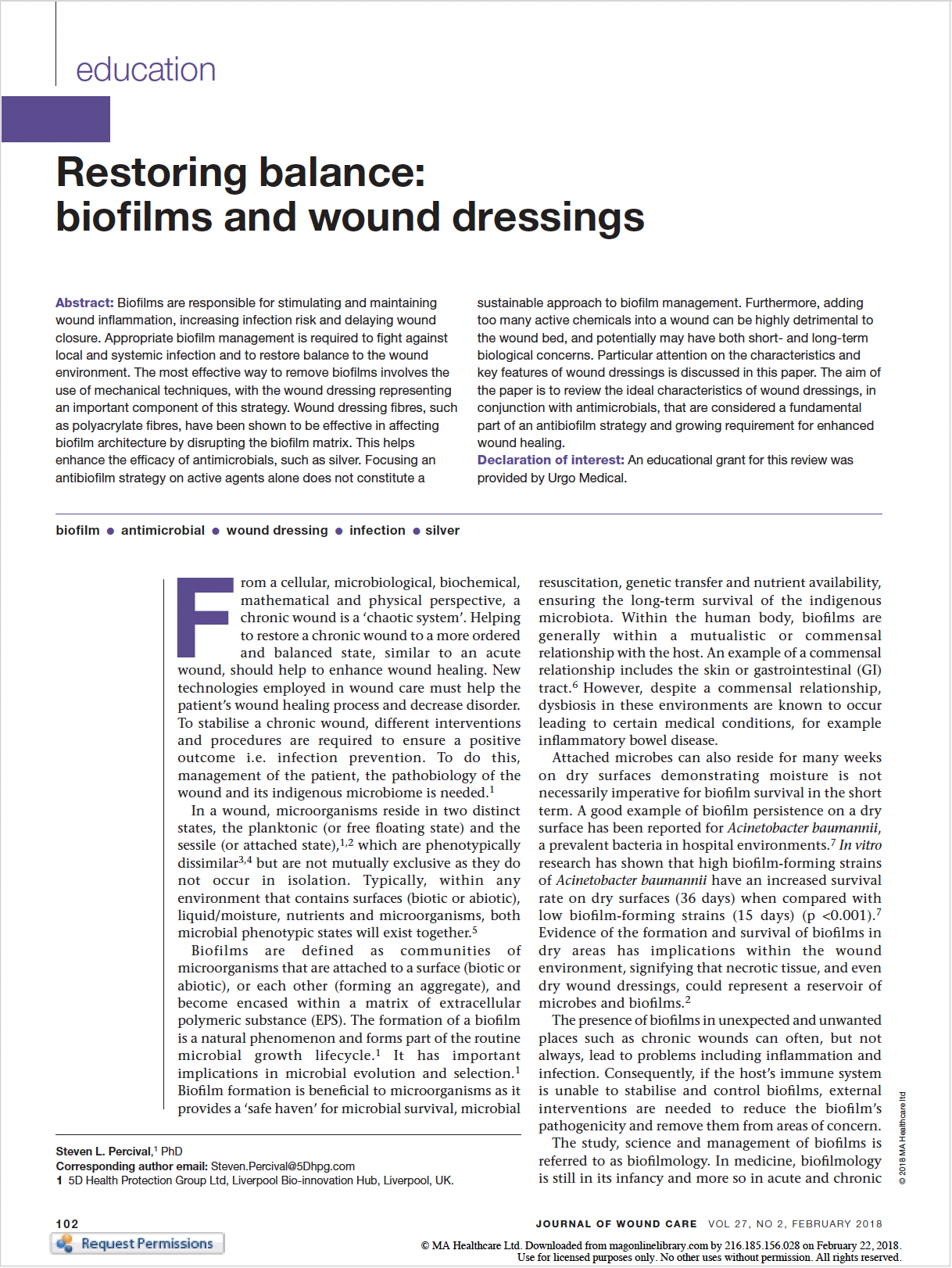
Restoring balance: biofilms and wound dressings
Biofilms are responsible for stimulating and maintaining wound inflammation, increasing infection risk and delaying wound closure. Appropriate biofilm management is required to fight against local and systemic infection and to restore balance to the wound environment. The most effective way to remove biofilms involves the use of mechanical techniques, with the wound dressing representing an important component of this strategy. Wound dressing fibres, such as polyacrylate fibres, have been shown to be effective in affecting biofilm architecture by disrupting the biofilm matrix.
Dalac Efficacy UCAG
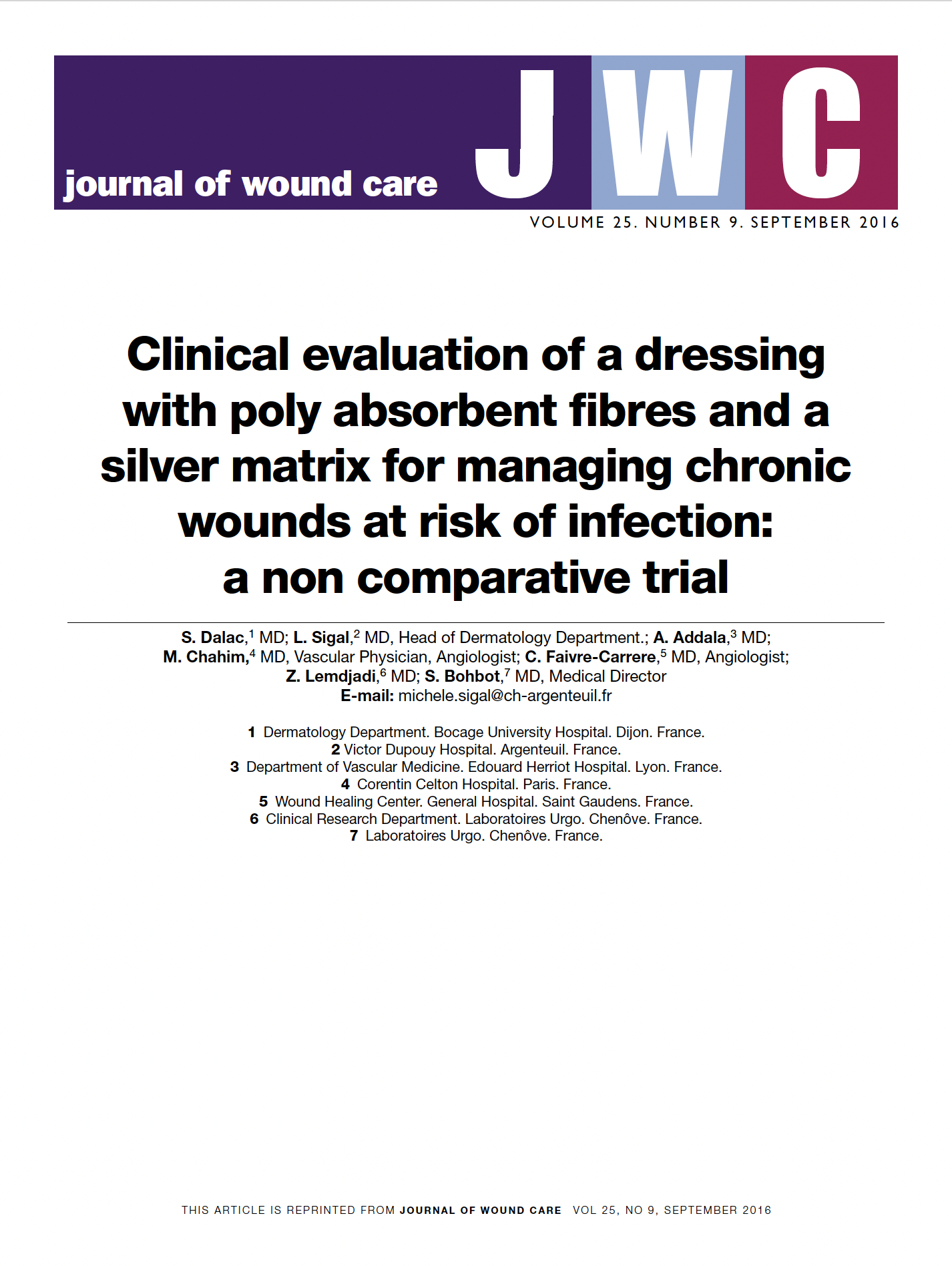
Clinical evaluation of a dressing with poly absorbent fibres and a silver matrix for managing chronic wounds at risk of infection: a non comparative trial
Objective: To assess the efficacy, safety and acceptability of a new silver poly absorbent dressing (UrgoCleanAg) in the local management of exudative chronic wounds at risk of infection, with inflammatory signs suggesting heavy bacterial load.
Dissemond TLC-AG Observacional
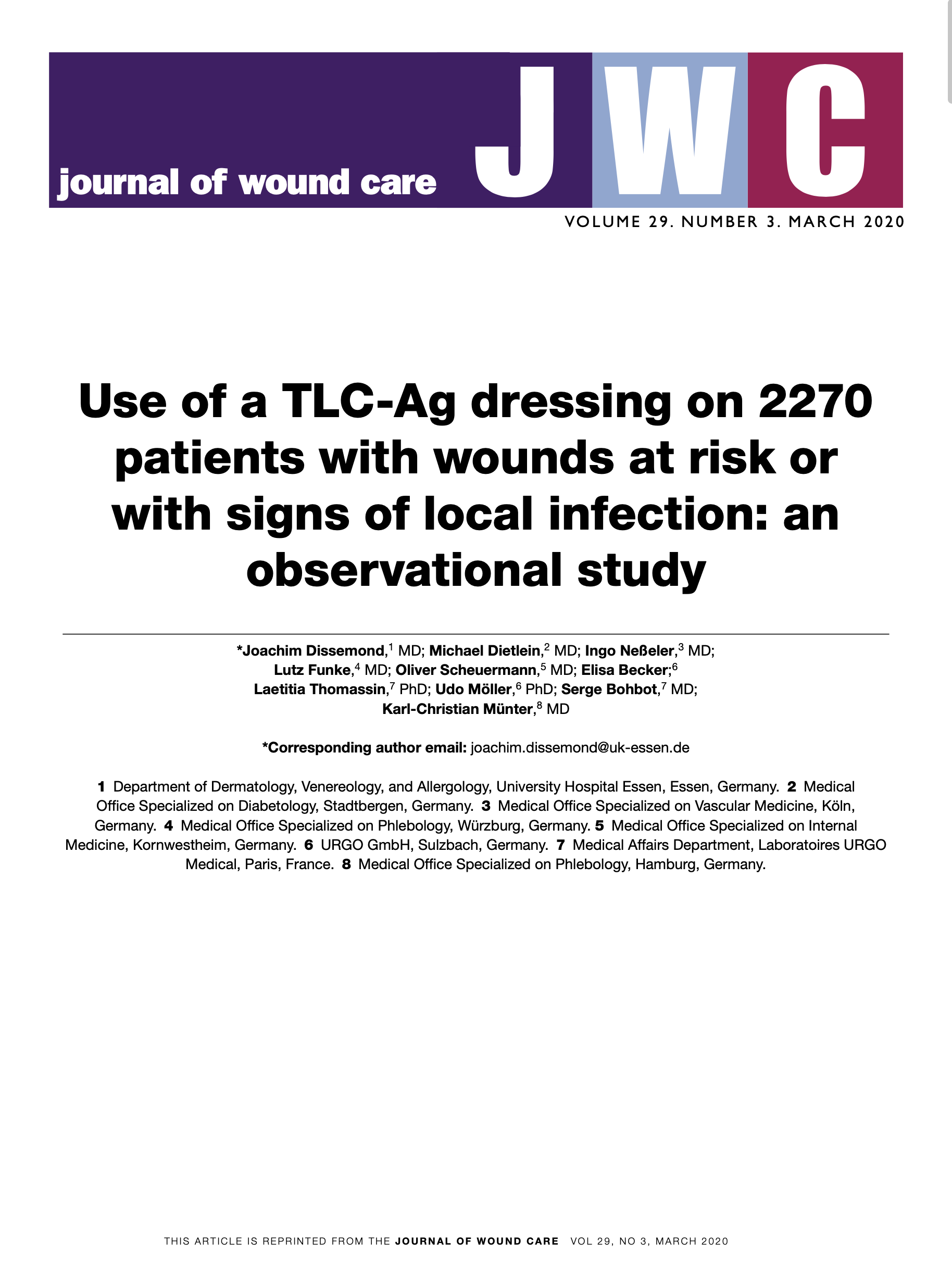
Use of a TLC-Ag dressing on 2270 patients with wounds at risk or with signs of local infection: an observational study
Objective: A description of wounds treated with a poly-absorbent silver dressing (with technology lipido-colloid with silver ions, TLC-Ag), and evaluation of the short-term clinical impact of the dressing on the wound healing process, under real-life conditions.
Lazareth Efficacy UTAG
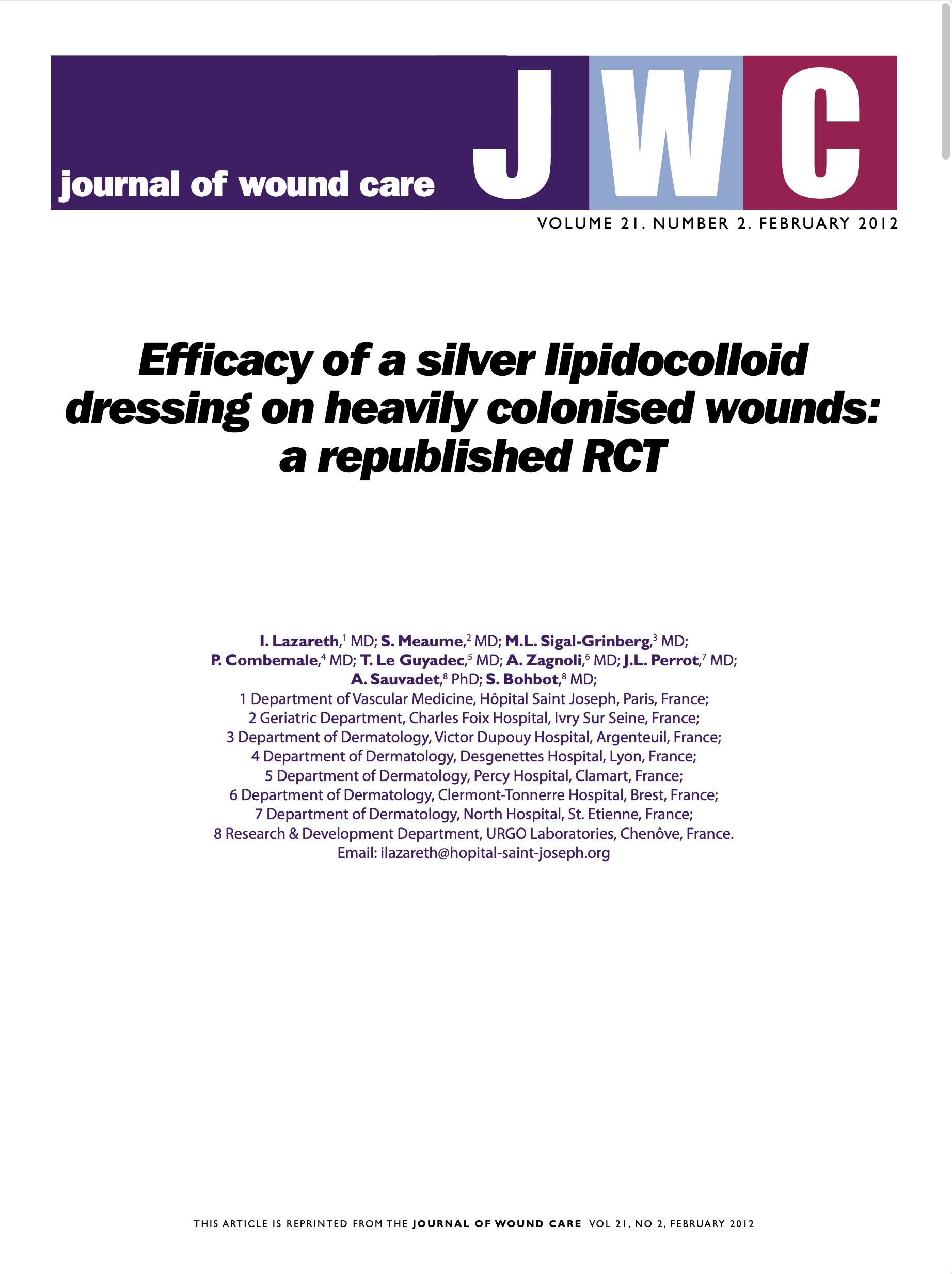
Efficacy of a silver lipidocolloid dressing on heavily colonised wounds: a republished RCT
Objective: To assess the ability of a silver lipidocolloid contact layer to promote the healing process of venous leg ulcers (vlus) presenting inflammatory signs, suggesting a heavy bacteria colonisation, and then delayed healing, in comparison with the same wound dressing not impregnated with silver salts.
URGO K1 - Freedom
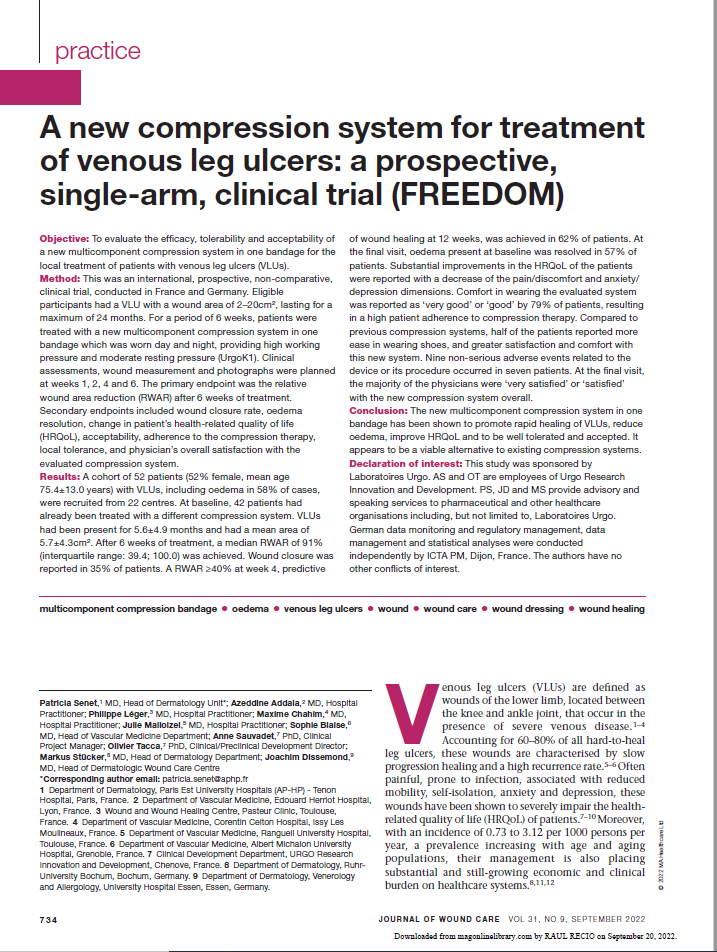
A new compression system for treatment of venous legs ulcer
The objectiva was to evaluate the efficacy, tolerability and acceptability of a new multicomponent compression system in one bandage for the local treatment of patients with venous leg ulcers (VLUs). Method: This was an international, prospective, non-comparative, clinical trial, conducted in France and Germany. Eligible participants had a VLU with a wound area of 2–20cm², lasting for a maximum of 24 months. For a period of 6 weeks, patients were treated with a new multicomponent compression system in one bandage which was worn day and night, providing high working pressure and moderate resting pressure (UrgoK1). Clinical assessments, wound measurement and photographs were planned at weeks 1, 2, 4 and 6. The primary endpoint was the relative wound area reduction (RWAR) after 6 weeks of treatment. Secondary endpoints included wound closure rate, oedema resolution, change in patient’s health-related quality of life (HRQoL), acceptability, adherence to the compression therapy, local tolerance, and physician’s overall satisfaction with the evaluated compression system.
URGO K1 - Benigni UK2 vs UK1
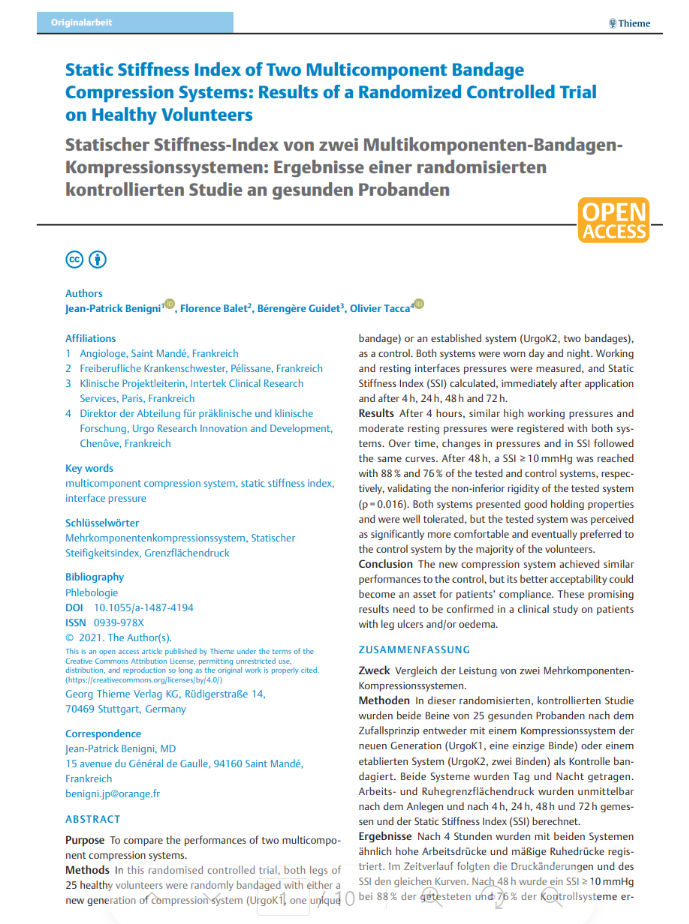
Static Stiffness Index of Two Multicomponent Bandage Compression Systems
Purpose: To compare the performances of two multicomponent compression systems. Methods: In this randomised controlled trial, both legs of 25 healthy volunteers were randomly bandaged with either a new generation of compression system (UrgoK1, one unique bandage) or an established system (UrgoK2, two bandages), as a control. Both systems were worn day and night. Working and resting interfaces pressures were measured, and Static Stiffness Index (SSI) calculated, immediately after application and after 4h, 24h, 48h and 72h.
URGO K2 - Hanna Pressure
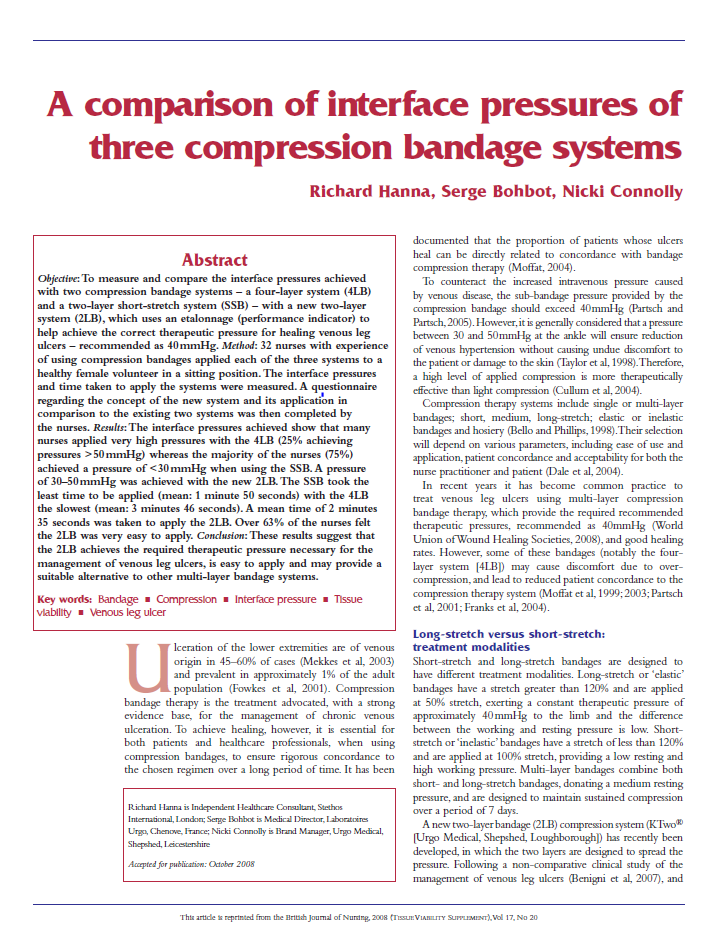
A comparison of interface pressures of three compression bandage systems
Objective: To measure and compare the interface pressures achieved with two compression bandage systems – a four-layer system (4LB) and a two-layer short-stretch system (SSB) – with a new two-layer system (2LB), which uses an etalonnage (performance indicator) to help achieve the correct therapeutic pressure for healing venous leg ulcers – recommended as 40 mmHg. Method: 32 nurses with experience of using compression bandages applied each of the three systems to a healthy female volunteer in a sitting position. The interface pressures and time taken to apply the systems were measured. A questionnaire regarding the concept of the new system and its application in comparison to the existing two systems was then completed by the nurses.
URGO K2 - Benigni Efficacy UK2
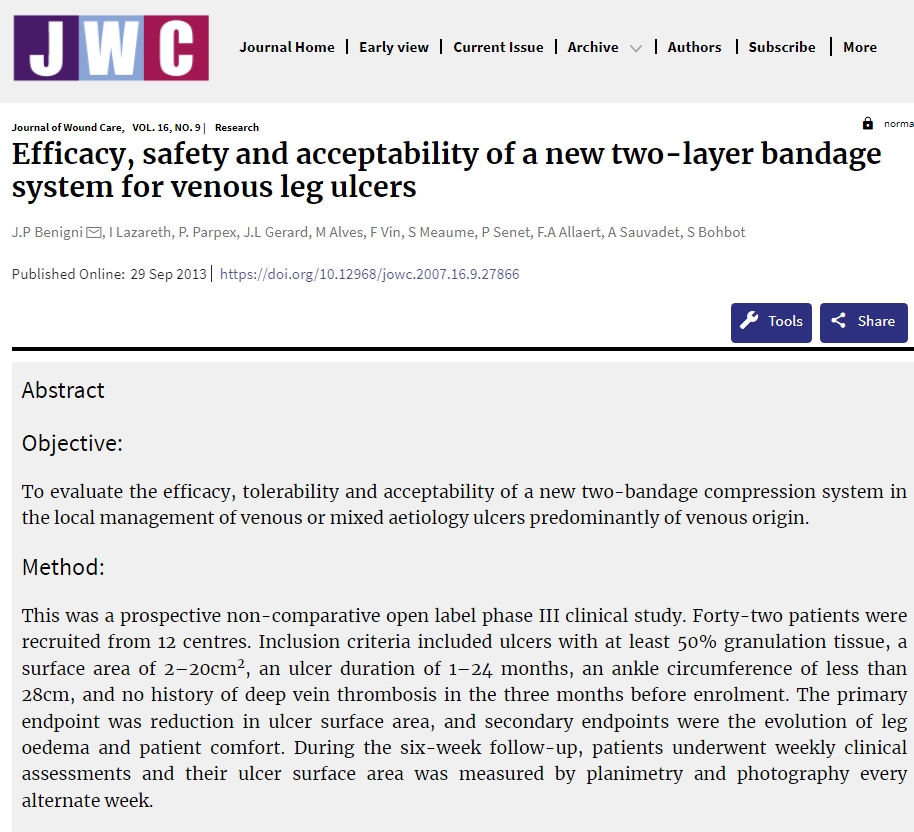
Efficacy, safety and acceptability of a new two-layer bandage system for venous leg ulcers
Objective: To evaluate the efficacy, tolerability and acceptability of a new two-bandage compression system in the local management of venous or mixed aetiology ulcers predominantly of venous origin. Method: This was a prospective non-comparative open label phase III clinical study. Forty-two patients were recruited from 12 centres. Inclusion criteria included ulcers with at least 50% granulation tissue, a surface area of 2–20cm2, an ulcer duration of 1–24 months, an ankle circumference of less than 28cm, and no history of deep vein thrombosis in the three months before enrolment. The primary endpoint was reduction in ulcer surface area, and secondary endpoints were the evolution of leg oedema and patient comfort. During the six-week follow-up, patients underwent weekly clinical assessments and their ulcer surface area was measured by planimetry and photography every alternate week.
URGO K2 - Junger Comparative study
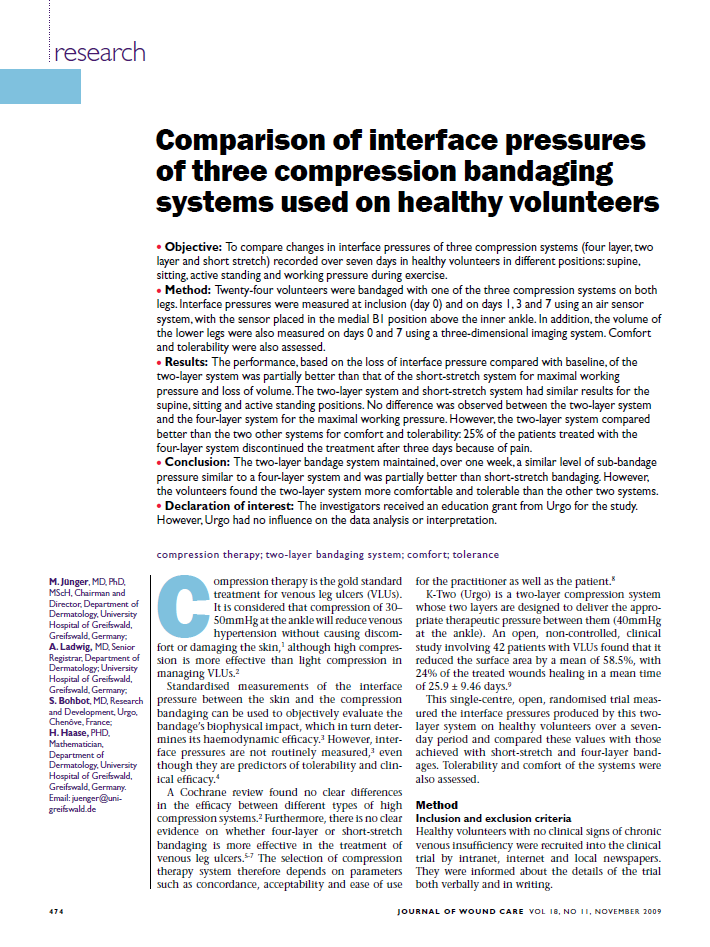
Comparison of interface pressures of three compression bandaging systems used on healthy volunteers
Objective: To compare changes in interface pressures of three compression systems (four layer, two layer and short stretch) recorded over seven days in healthy volunteers in different positions: supine, sitting, active standing and working pressure during exercise. Method: Twenty-four volunteers were bandaged with one of the three compression systems on both legs. Interface pressures were measured at inclusion (day 0) and on days 1, 3 and 7 using an air sensor system, with the sensor placed in the medial B1 position above the inner ankle. In addition, the volume of the lower legs were also measured on days 0 and 7 using a three-dimensional imaging system. Comfort and tolerability were also assessed.
URGO K2 - Stucker observational study
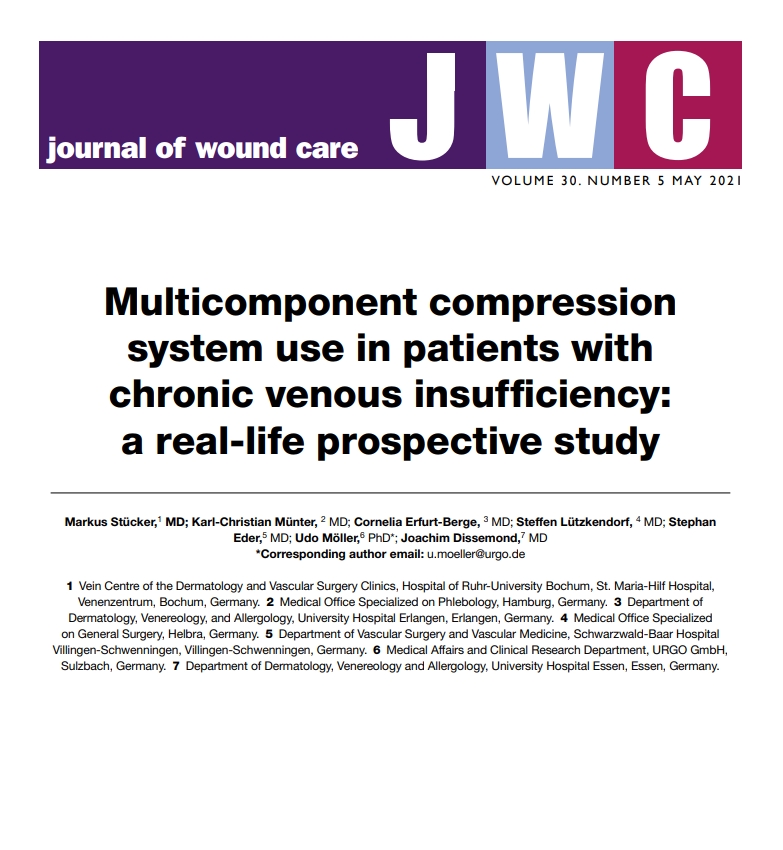
Multicomponent compression system use in patients with chronic venous insufficiency: a real-life prospective study
Objective: Compression therapy is the cornerstone of therapeutic management of patients with chronic venous insufficiency (CVI). This study aimed to evaluate the efficacy and safety of a multicomponent compression system in an unselected population of patients with CVI problems under real-life conditions. Method: A prospective, multicentre, observational study with a multicomponent two-bandage compression system (UrgoK2, Laboratoires Urgo, France) was conducted in 103 centres in Germany. Main outcomes included wound healing rate, wound healing progression, assessment of oedema and ankle mobility, local tolerability and acceptance of the compression therapy
UK2 Meaume SNDS
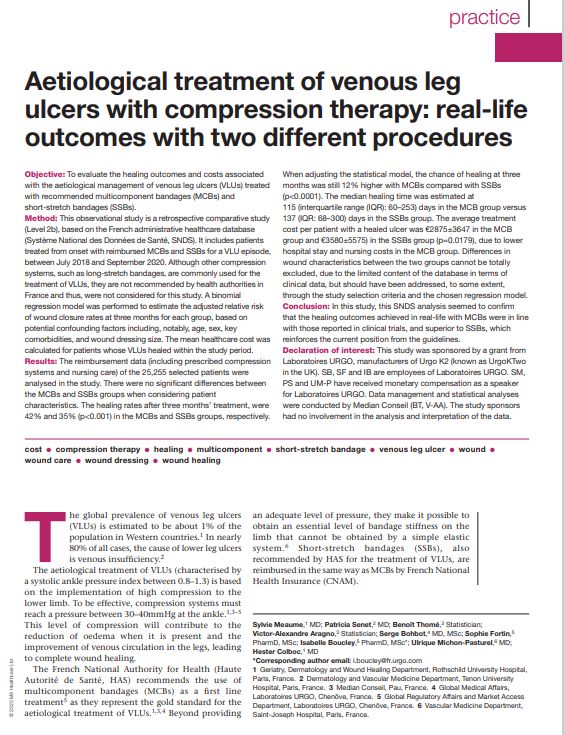
Aetiological treatment of venous leg ulcers with compression therapy
Objective: To evaluate the healing outcomes and costs associated with the aetiological management of venous leg ulcers (VLUs) treated with recommended multicomponent bandages (MCBs) and short‑stretch bandages (SSBs). Method: This observational study is a retrospective comparative study (Level 2b), based on the French administrative healthcare database (Système National des Données de Santé, SNDS). It includes patients treated from onset with reimbursed MCBs and SSBs for a VLU episode, between July 2018 and September 2020. Although other compression systems, such as long-stretch bandages, are commonly used for the treatment of VLUs, they are not recommended by health authorities in France and thus, were not considered for this study
USP - Abejón Arroyo - Coste-efectividad
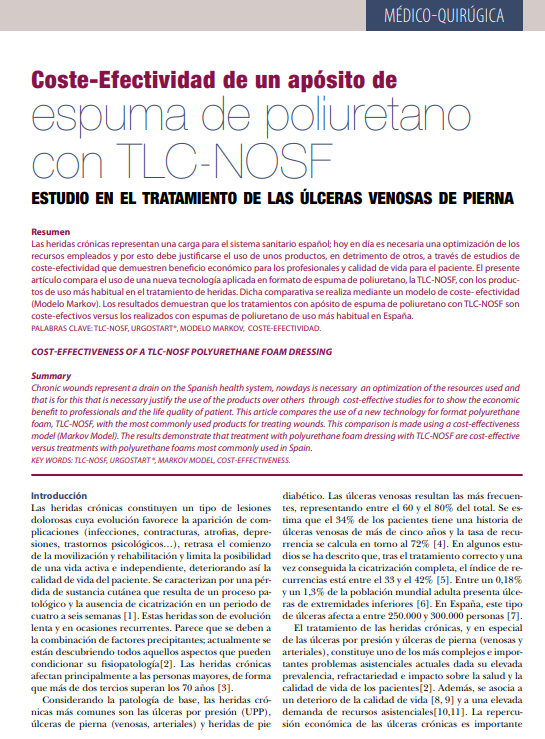
Coste-Efectividad de un apósito de espuma de poliuretano con TLC-NOSF
Las heridas crónicas representan una carga para el sistema sanitario español; hoy en día es necesaria una optimización de los recursos empleados y por esto debe justificarse el uso de unos productos, en detrimento de otros, a través de estudios de coste-efectividad que demuestren beneficio económico para los profesionales y calidad de vida para el paciente. El presente artículo compara el uso de una nueva tecnología aplicada en formato de espuma de poliuretano, la TLC-NOSF, con los productos de uso más habitual en el tratamiento de heridas. Dicha comparativa se realiza mediante un modelo de coste- efectividad (Modelo Markov). Los resultados demuestran que los tratamientos con apósito de espuma de poliuretano con TLC-NOSF son coste-efectivos versus los realizados con espumas de poliuretano de uso más habitual en España.
UK2+USP Meaume SNDS 2
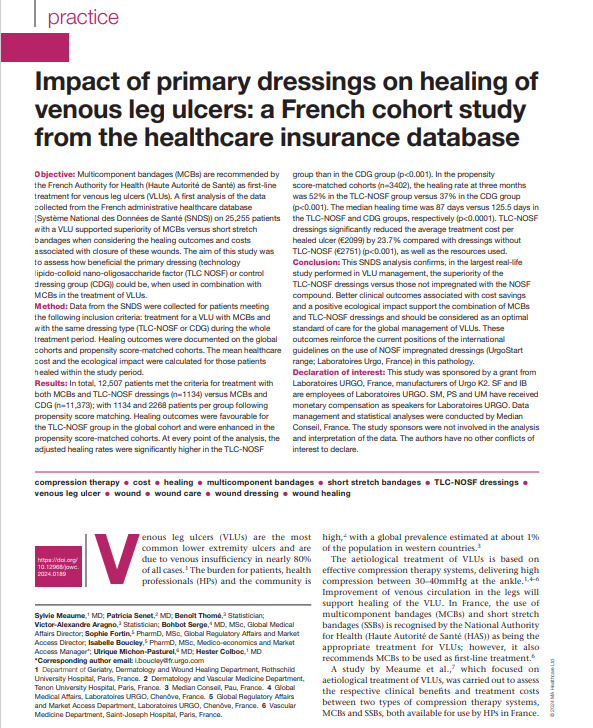
Impact of primary dressings on healing of venous leg ulcers
Objective: Multicomponent bandages (MCBs) are recommended by the French Authority for Health (Haute Autorité de Santé) as first-line treatment for venous leg ulcers (VLUs). A first analysis of the data collected from the French administrative healthcare database (Système National des Données de Santé (SNDS)) on 25,255 patients with a VLU supported superiority of MCBs versus short stretch bandages when considering the healing outcomes and costs associated with closure of these wounds. The aim of this study was to assess how beneficial the primary dressing (technology lipido-colloid nano-oligosaccharide factor (TLC NOSF) or control dressing group (CDG)) could be, when used in combination with MCBs in the treatment of VLUs. Method: Data from the SNDS were collected for patients meeting the following inclusion criteria: treatment for a VLU with MCBs and with the same dressing type (TLC-NOSF or CDG) during the whole treatment period. Healing outcomes were documented on the global cohorts and propensity score-matched cohorts. The mean healthcare cost and the ecological impact were calculated for those patients healed within the study period.
Fibras Meaume Ensayo clínico

Tratamiento de heridas crónicas con un apósito absorbente innovador
Objetivo: Evaluar la eficacia y tolerabilidad de un innovador apósito absorbente (UrgoClean, de Laboratorios URGO) para el tratamiento local de úlceras venosas de pierna y úlceras por presión durante la fase de desbridamiento del proceso de cicatrización. l Método: Ensayo clínico piloto, prospectivo, de adición y no controlado, llevado a cabo en 21 centros de investigación. En el estudio participaron pacientes adultos que presentaban, ya sea úlceras venosas de pierna (VLU, por sus siglas en inglés) o bien úlceras por presión (PU, por sus siglas en inglés) de la categoría lll/IV, con más del 50% de la superficie cubierta de tejido esfacelado. La duración del estudio no sobrepasó los 24 meses y no se registraron signos clínicos de infección. Los pacientes fueron observados durante un periodo de 6 semanas, con visitas semanales en las que el médico investigador llevó a cabo exámenes físicos y mediciones de la zona de la herida, además de tomar fotografías. En cada cambio de apósito, tanto el personal enfermero como el paciente efectuaron evaluaciones de la herida.
Fibras Dalac
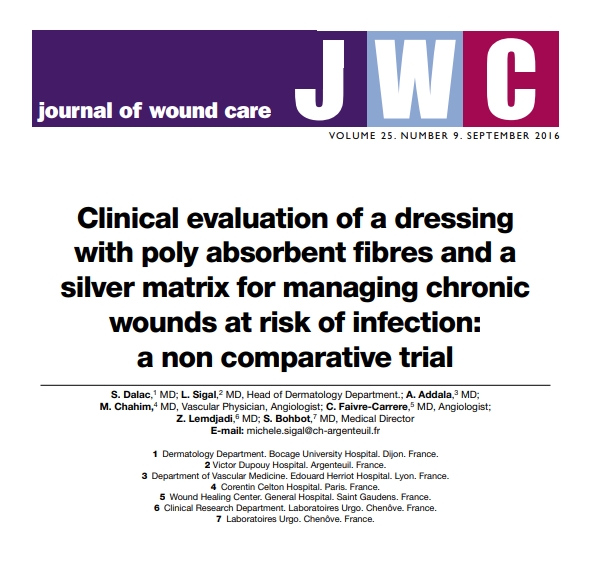
Clinical evaluation of a dressing with poly absorbent fibres and a silver matrix for managing chronic wounds at risk of infection: a non comparative trial
Objective: To assess the efficacy, safety and acceptability of a new silver poly absorbent dressing (UrgoCleanAg) in the local management of exudative chronic wounds at risk of infection, with inflammatory signs suggesting heavy bacterial load. Method: This prospective, multicentre, non-comparative clinical trial was conducted in French hospital wards (dermatology and vascular medicine) or specialised private-practice physicians. Patients were considered at high-risk of infection when presenting with at least three of five selected inflammatory clinical signs, suggesting a heavy bacterial load (pain between two dressing changes, erythema, oedema, malodorous wound and presence of a heavy exudate). They were treated for a maximum period of four weeks, and followed by the physician on a weekly basis, including a clinical examination, area tracings and photographs. The primary efficacy criterion of the trial was the relative wound surface area reduction at the end of the four weeks of treatment. Acceptability was documented by the nursing staff at each dressing change between the weekly evaluations.
Fibras Dissemons Observational study
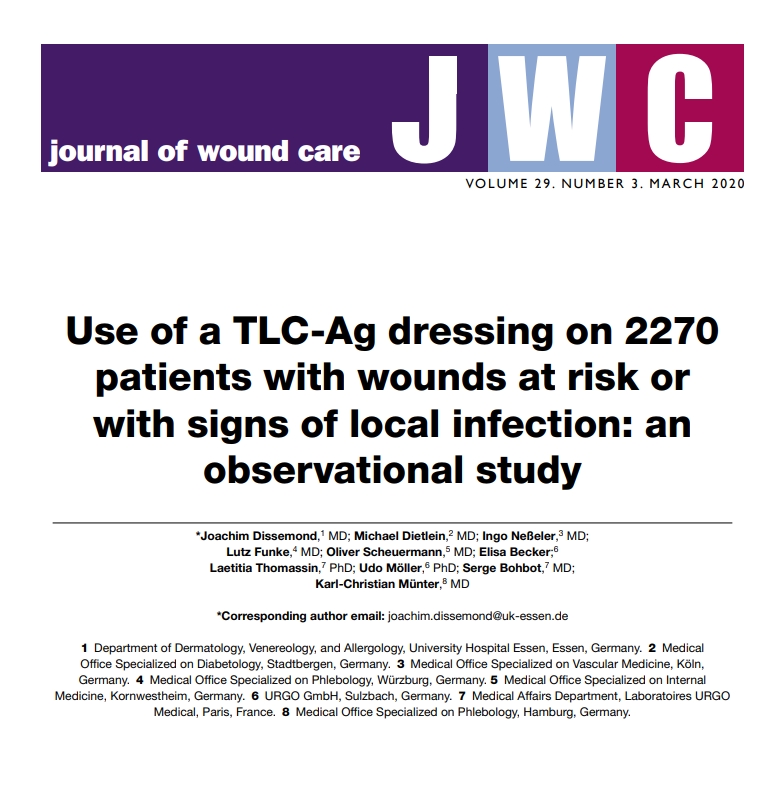
Use of a TLC-Ag dressing on 2270 patients with wounds at risk or with signs of local infection: an observational study
Objective: A description of wounds treated with a poly-absorbent silver dressing (with technology lipido-colloid with silver ions, TLC-Ag), and evaluation of the short-term clinical impact of the dressing on the wound healing process, under real-life conditions. Method: A large, prospective, multicentre, observational study of patients in 81 centres in Germany, presenting with an exuding wound at risk or with clinical signs of local infection for whom the evaluated TLC-Ag dressing (UrgoClean Ag, Laboratoires Urgo, France) has been prescribed. Main outcomes included: reduction in number of wound infections diagnosed and clinical signs of local infection, wound healing rate, clinical assessment of wound healing progression, relative wound area reduction (RWAR), local tolerability, handling and acceptance of the dressing.
Fibras Desroche Antibacterial+Antibiofilm
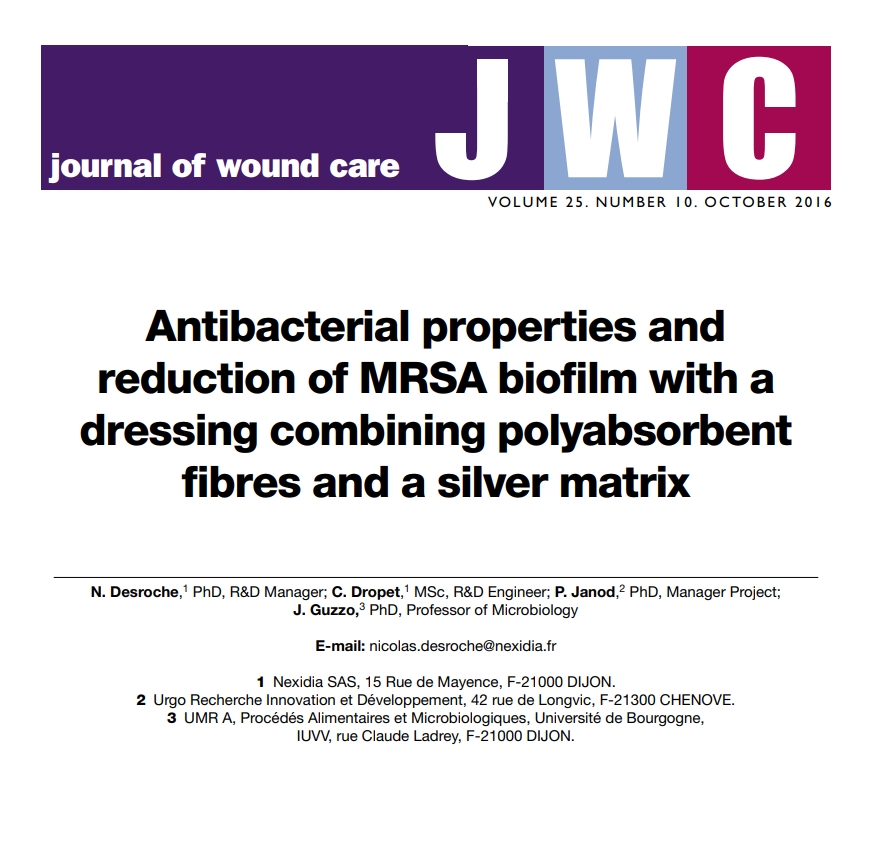
Antibacterial properties and reduction of MRSA biofilm with a dressing combining polyabsorbent fibres and a silver matrix
Objective: This study was designed to evaluate the antibacterial activity of a wound dressing which combines polyacrylate fibres and a silver lipido-colloid matrix (UrgoClean Ag, silver polyabsorbent dressing), against biofilm of methicillin-resistant Staphylococcus aureus (MRSA). Method: Samples of silver polyabsorbent dressing and the neutral form of this dressing (UrgoClean) were applied to biofilms of MRSA formed on a collagen I-coated surface, cultured for 24 hours. Different exposure times were tested (1, 2, 4 and 7 days) without dressing change. The biofilm reduction was quantified by using culture methods and by confocal laser scanning microscopy experiments.
Athac UT Verdu

Estudio observacional sobre el uso de apósitos neutros o impregnados en TLC para el tratamiento de heridas
El estudio ATHAC recoge datos sobre heridas agudas y crónicas que son candidatas a un tratamiento a base de apósitos grasos neutros como la gama URGOTUL. Objetivos: Describir las características de las heridas, describir los tratamiento aplicados a estas heridas y explorar las opiniones de los profesionales de enfermería y los pacientes sobre los tratamientos en términos de aplicabilidad, adaptabilidad y confort para el paciente. Material y métodos: 1.500 pacientes fueron incluidos en el estudio de acuerdo al tipo de herida y a los tratamientos en uso. Se recogieron datos a partir de dos cuestionarios: uno para el paciente y otro para la enfermera responsable de sus cuidados. Las enfermeras recogieron los datos en el primer día de inclusión y los pacientes respondían al cuestionario 1 mes más tarde o antes si la herida había cicatrizado. Las variables recogidas por la enfermera fueron: datos sociodemográficos, etiología de las lesiones, características y localización de las heridas, aspectos y opiniones sobre el tratamiento.
Estudio MAPP-UT
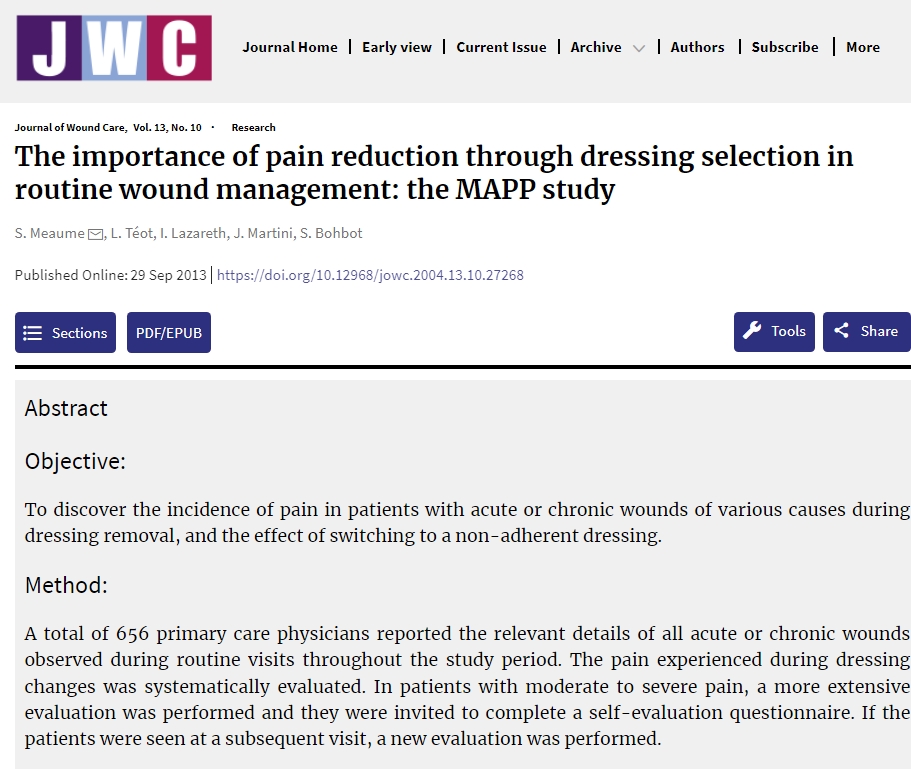
The importance of pain reduction through dressing selection in routine wound management
Objective: To discover the incidence of pain in patients with acute or chronic wounds of various causes during dressing removal, and the effect of switching to a non-adherent dressing. Method: A total of 656 primary care physicians reported the relevant details of all acute or chronic wounds observed during routine visits throughout the study period. The pain experienced during dressing changes was systematically evaluated. In patients with moderate to severe pain, a more extensive evaluation was performed and they were invited to complete a self-evaluation questionnaire. If the patients were seen at a subsequent visit, a new evaluation was performed.
Maureen UT en heridas agudas y crónicas
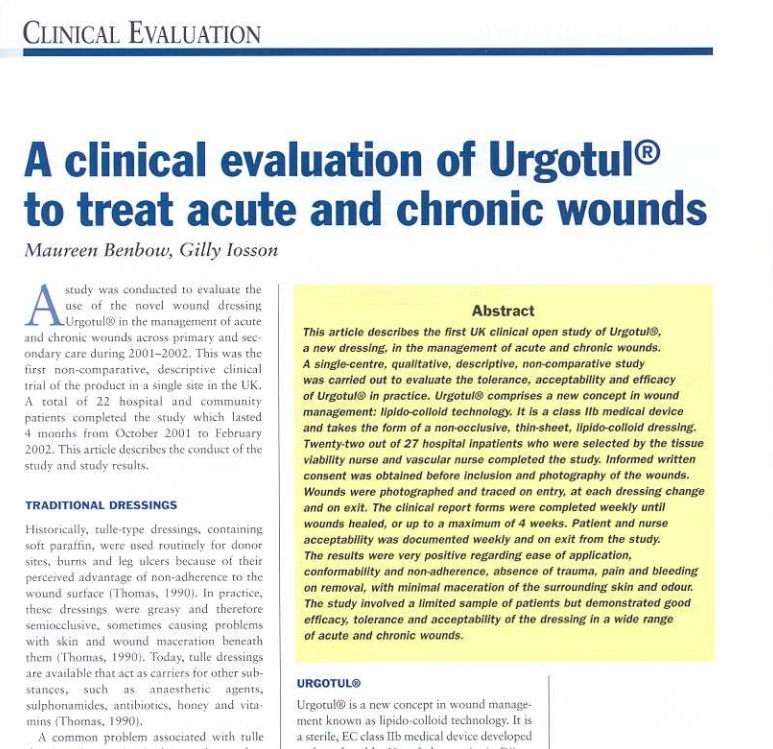
A clinical evaluation of UrgoTul to treat acute and chronic wounds
This article describes the first UK clinical open study of Urgotul®, a new dressing, in the management of acute and chronic wounds. A single-centre, qualitative, descriptive, non-comparative study was carried out to evaluate the tolerance, acceptability and efficacy of Urgotul® in practice. Urgotul® comprises a new concept in wound management: lipido-colloid technology. It is a class IIb medical device and takes the form of a non-occlusive, thin-sheet, lipido-colloid dressing. Twenty-two out of 27 hospital inpatients who were selected by the tissue viability nurse and vascular nurse completed the study. Informed written consent was obtained before inclusion and photography of the wounds. Wounds were photographed and traced on entry, at each dressing change and on exit. The clinical report forms were completed weekly until wounds healed, or up to a maximum of 4 weeks. Patient and nurse acceptability was documented weekly and on exit from the study. The results were very positive regarding ease of application, conformability and non-adherence, absence of trauma, pain and bleeding on removal, with minimal maceration of the surrounding skin and odour. The study involved a limited sample of patients but demonstrated good efficacy, tolerance and acceptability of the dressing in a wide range of acute and chronic wounds.
Pediatria LETOUZE
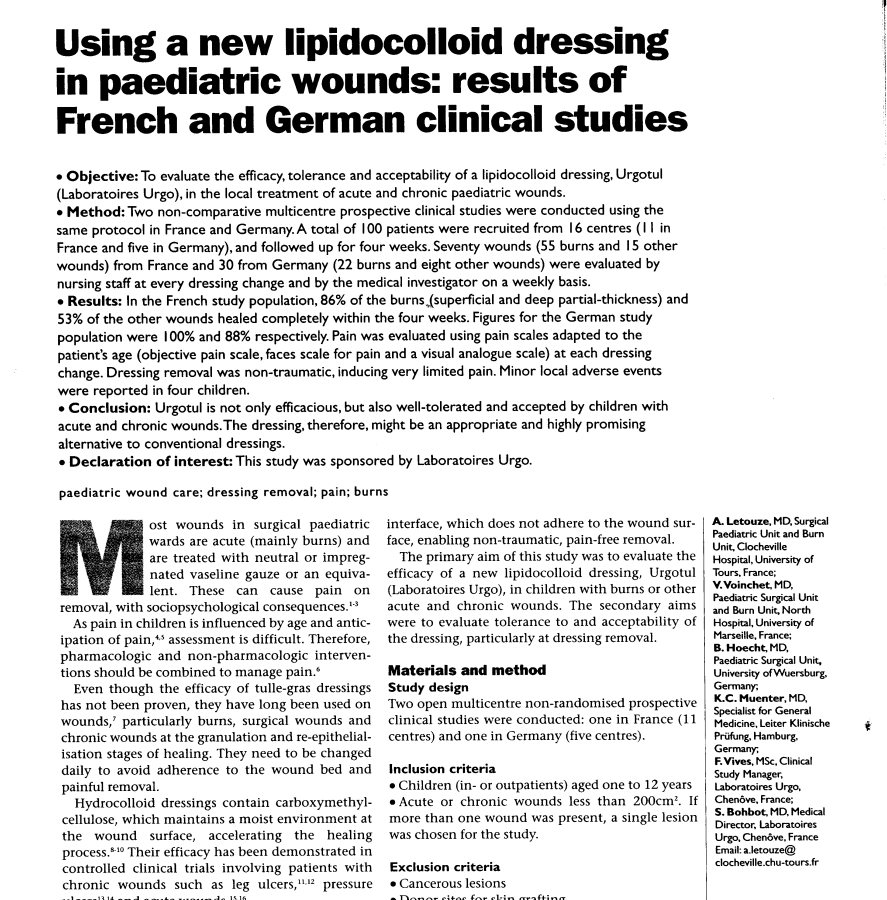
Using a new lipidocolloid dressing in paediatric wounds: results of French and German clinical studies
Objective: To evaluate the efficacy, tolerance and acceptability of a lipidocolloid dressing, Urgotul (Laboratoires Urgo), in the local treatment of acute and chronic paediatric wounds. Method: Two non-comparative multicentre prospective clinical studies were conducted using the same protocol in France and Germany. A total of 100 patients were recruited from 16 centres (11 in France and five in Germany), and followed up for four weeks. Seventy wounds (55 burns and 15 other wounds) from France and 30 from Germany (22 burns and eight other wounds) were evaluated by nursing staff at every dressing change and by the medical investigator on a weekly basis.
Burton UT Traumatic Wounds

An evaluation of non-adherent wound-contact layers for acute traumatic and surgical wounds
A traumatic or non-adherent wound contact dressings are most often used at the proliferative stage of healing to promote granulation and epithelisation. However, there is limited evidence of their efficacy and cost-effectiveness. Consequently, deciding which product to use is often confusing and based on personal preference, which can result in inconsistencies. The accident and emergency departments and outpatient clinics at University Hospitals Coventry and Warwickshire NHS Trust were using a variety of products for the management of acute traumatic and surgical wounds. This was causing confusion among staff and patients and unnecessary painful dressing changes, and was delaying healing. This study set out to evaluate the effectiveness and acceptability of five low-adherent dressings in clinical practice. Healing rates were not formally compared, although anecdotal observations were noted. A unit-cost comparison was also done to facilitate future procurement.
Bernard Fibroblast study
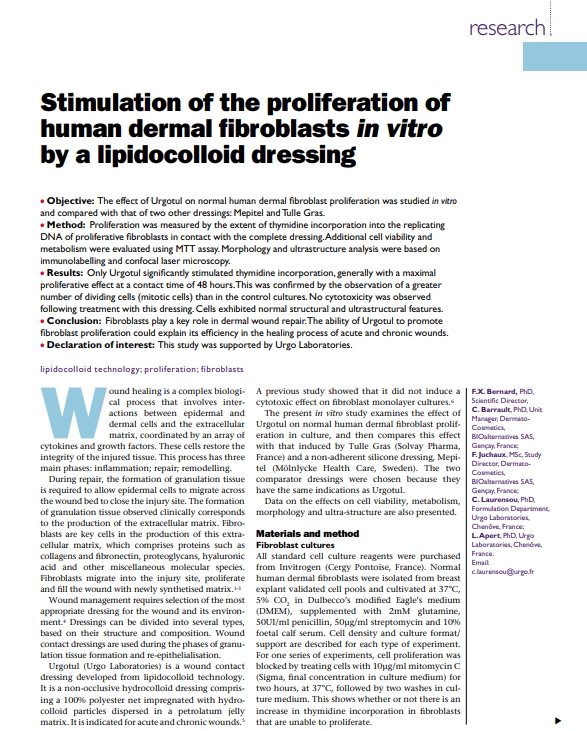
Stimulation of the proliferation of human dermal fibroblasts in vitro by a lipidocolloid dressing
Objective: The effect of Urgotul on normal human dermal fibroblast proliferation was studied in vitr and compared with that of two other dressings: Mepitel and Tulle Gras. l Method: Proliferation was measured by the extent of thymidine incorporation into the replicating DNA of proliferative fibroblasts in contact with the complete dressing. Additional cell viability and metabolism were evaluated using MTT assay. Morphology and ultrastructure analysis were based on immunolabelling and confocal laser microscopy. l Results: Only Urgotul significantly stimulated thymidine incorporation, generally with a maxima proliferative effect at a contact time of 48 hours. This was confirmed by the observation of a greater number of dividing cells (mitotic cells) than in the control cultures. No cytotoxicity was observed following treatment with this dressing. Cells exhibited normal structural and ultrastructural features.
Bohbot y Blanchet UT en EB
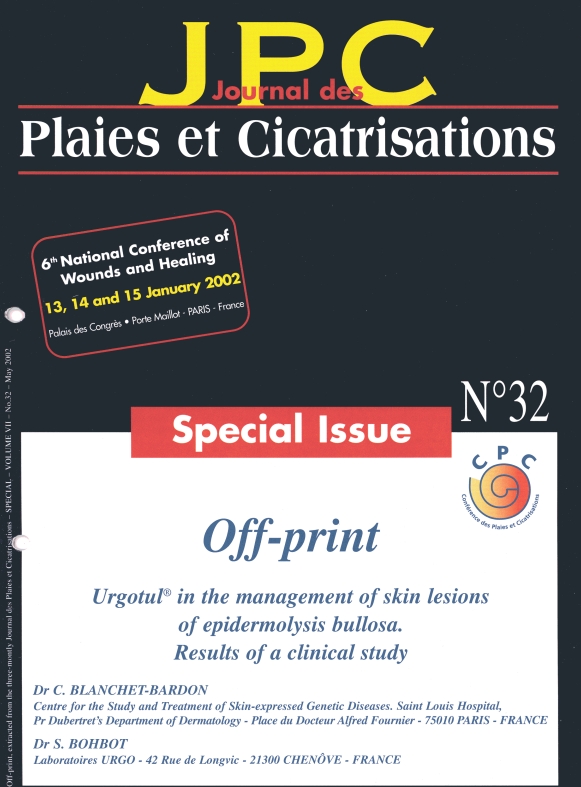
Using Urgotul dressing for the management of epidermolysis bullosa skin lesions
Objective: To evaluate the acceptability, tolerance and efficacy of Urgotul wound dressing in the management of epidermolysis bullosa (EB) skin lesions. Method: This was an open-label uncontrolled clinical trial involving 20 patients (I I adults and nine children) with EB simplex or dystrophic EB. Patients were selected from the register of EB patients at the investigating centre and included if they presented with at least one skin lesion requiring management with a non-adherent wound dressing. Lesions were treated with the study dressing for a maximum of four weeks. All dressing changes, wound parameters, pain and effect on quality of life were recorded. Results: All patients completed the trial. Nineteen out of 20 wounds healed within 8.7 +/- 8.5 days. Overall, 11 patients (55%) considered that their quality of life had improved following use of the dressing, which was also reported to be pain free and 'very easy' or 'easy' to remove at most dressing changes. Nineteen out of 20 patients stated that they would use the study dressing to manage their lesions in future.
Humbert y Viennet In vitro UT
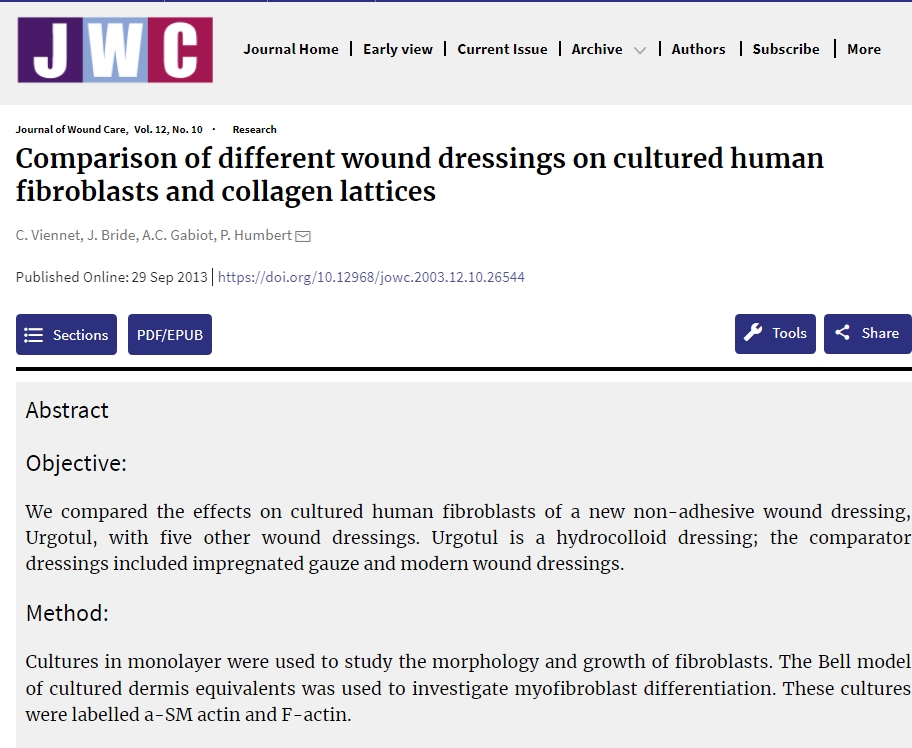
Comparison of different wound dressings on cultured human fibroblasts and collagen lattices
Objective: We compared the effects on cultured human fibroblasts of a new non-adhesive wound dressing, Urgotul, with five other wound dressings. Urgotul is a hydrocolloid dressing; the comparator dressings included impregnated gauze and modern wound dressings. Method: Cultures in monolayer were used to study the morphology and growth of fibroblasts. The Bell model of cultured dermis equivalents was used to investigate myofibroblast differentiation. These cultures were labelled a-SM actin and F-actin. Results: Two of the tested dressings induced cytotoxic effects. They were found to inhibit cell growth (greater than 60%) and to disturb cell shape and cytoskeletal differentiation. Urgotul and the remaining three dressings showed no effect on proliferation. However, some of them modified fibroblast morphology and affected F-actin distribution. Conclusion: Depending on their nature and components, wound dressings may respect or affect fibroblast behaviour in vitro (proliferation, morphology and a-SM actin and F-actin distribution). The significance of these in vitro observed findings require further investigations.
Dissemond Review MMPs
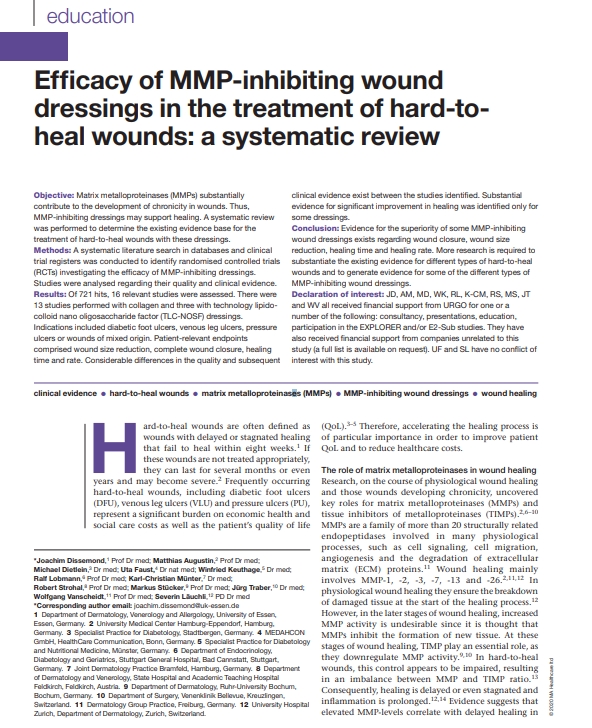
Efficacy of MMP-inhibiting wound dressings in the treatment of hard-to heal wounds: a systematic revie
Objective: Matrix metalloproteinases (MMPs) substantially contribute to the development of chronicity in wounds. Thus, MMP‑inhibiting dressings may support healing. A systematic review was performed to determine the existing evidence base for the treatment of hard-to-heal wounds with these dressing Methods: A systematic literature search in databases and clinical trial registers was conducted to identify randomised controlled trials (RCTs) investigating the efficacy of MMP-inhibiting dressings. Studies were analysed regarding their quality and clinical evidence. Results: Of 721 hits, 16 relevant studies were assessed. There were 13 studies performed with collagen and three with technology lipido colloid nano oligosaccharide factor (TLC-NOSF) dressings. Indications included diabetic foot ulcers, venous leg ulcers, pressure ulcers or wounds of mixed origin. Patient-relevant endpoints comprised wound size reduction, complete wound closure, healing time and rate. Considerable differences in the quality and subsequent clinical evidence exist between the studies identified. Substantial evidence for significant improvement in healing was identified only for some dressings.
What Schmutz
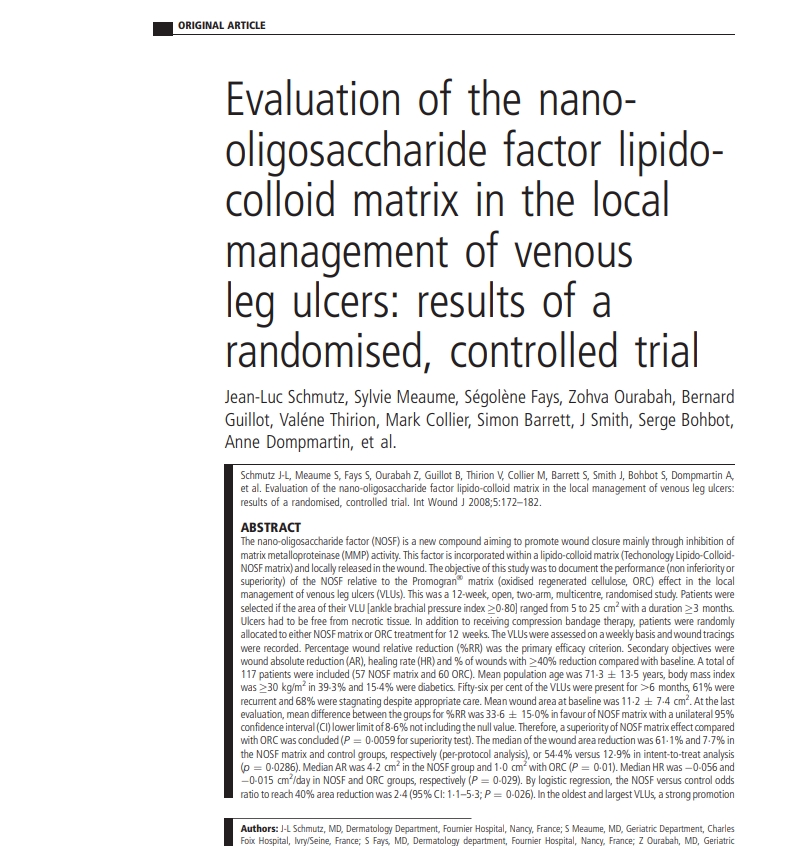
Evaluation of the nano oligosaccharide factor lipido colloid matrix in the local management of venous leg ulcers
The nano-oligosaccharide factor (NOSF) is a new compound aiming to promote wound closure mainly through inhibition of matrix metalloproteinase (MMP) activity. This factor is incorporated within a lipido-colloid matrix (Techonology Lipido-Colloid NOSF matrix) and locally released inthe wound. The objective of this study wasto document the performance (non inferiority or superiority) of the NOSF relative to the Promogran matrix (oxidised regenerated cellulose, ORC) effect in the local management of venous leg ulcers (VLUs). This was a 12-week, open, two-arm, multicentre, randomised study. Patients were selected if the area of their VLU [ankle brachial pressure index 080] ranged from 5 to 25 cm2 with a duration 3 months. Ulcers had to be free from necrotic tissue. In addition to receiving compression bandage therapy, patients were randomly allocated to either NOSFmatrix or ORC treatment for 12 weeks. The VLUs were assessed on a weekly basis and woundtracings were recorded. Percentage wound relative reduction (%RR) was the primary efficacy criterion. Secondary objectives were wound absolute reduction (AR), healing rate (HR) and % of wounds with 40% reduction compared with baseline. A total of 117 patients were included (57 NOSF matrix and 60 ORC). Mean population age was 71-3 +- 13-5 years, body mass index was 30 kg/m2 in 39-3% and 15-4% were diabetics. Fifty-six per cent of the VLUs were present for .6 months, 61% were recurrent and 68% were stagnating despite appropriate care.
Reality Munter
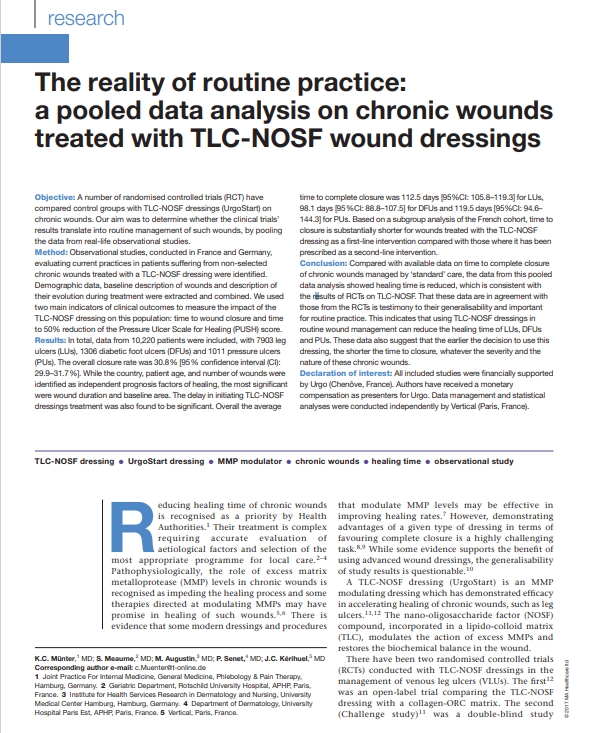
The reality of routine practice: a pooled data analysis on chronic wounds treated with TLC-NOSF wound dressings
Objective: A number of randomised controlled trials (RCT) have compared control groups with TLC-NOSF dressings (UrgoStart) on chronic wounds. Our aim was to determine whether the clinical trials’ results translate into routine management of such wounds, by pooling the data from real-life observational studies. Method: Observational studies, conducted in France and Germany, evaluating current practices in patients suffering from non-selected chronic wounds treated with a TLC-NOSF dressing were identified. Demographic data, baseline description of wounds and description of their evolution during treatment were extracted and combined. We used two main indicators of clinical outcomes to measure the impact of the TLC-NOSF dressing on this population: time to wound closure and time to 50% reduction of the Pressure Ulcer Scale for Healing (PUSH) score.
Explorer
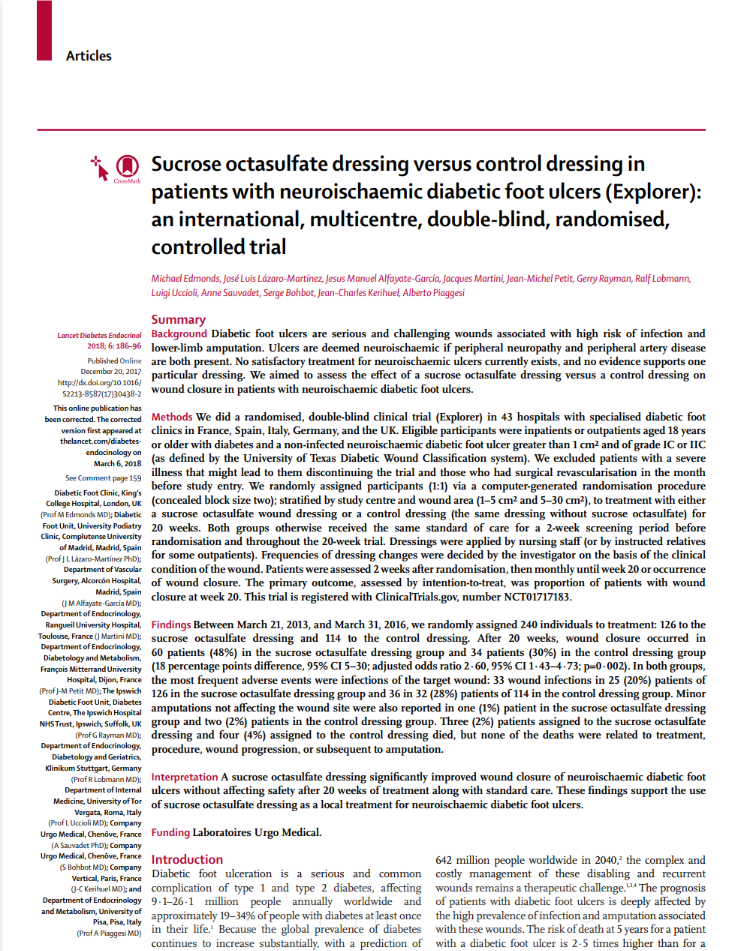
Sucrose octasulfate dressing versus control dressing in patients with neuroischaemic diabetic foot ulcers
Diabetic foot ulcers are serious and challenging wounds associated with high risk of infection and lower-limb amputation. Ulcers are deemed neuroischaemic if peripheral neuropathy and peripheral artery disease are both present. No satisfactory treatment for neuroischaemic ulcers currently exists, and no evidence supports one particular dressing. We aimed to assess the effect of a sucrose octasulfate dressing versus a control dressing on wound closure in patients with neuroischaemic diabetic foot ulcers. Methods We did a randomised, double-blind clinical trial (Explorer) in 43 hospitals with specialised diabetic foot clinics in France, Spain, Italy, Germany, and the UK. Eligible participants were inpatients or outpatients aged 18 years or older with diabetes and a non-infected neuroischaemic diabetic foot ulcer greater than 1 cm2 and of grade IC or IIC (as defined by the University of Texas Diabetic Wound Classification system). We excluded patients with a severe illness that might lead to them discontinuing the trial and those who had surgical revascularisation in the month before study entry.
Challenge
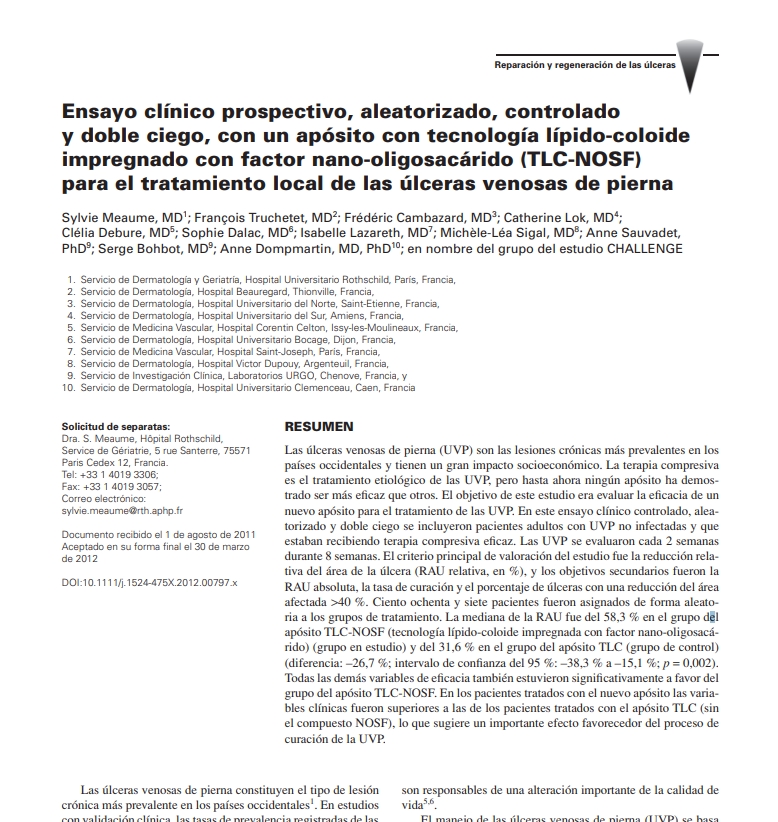
Ensayo clínico prospectivo, aleatorizado, controlado y doble ciego, con un apósito con tecnología lípido-coloide impregnado con factor nano-oligosacárido (TLC-NOSF) para el tratamiento local de las úlceras venosas de pierna
Las úlceras venosas de pierna (UVP) son las lesiones crónicas más prevalentes en los países occidentales y tienen un gran impacto socioeconómico. La terapia compresiva es el tratamiento etiológico de las UVP, pero hasta ahora ningún apósito ha demostrado ser más eficaz que otros. El objetivo de este estudio era evaluar la eficacia de un nuevo apósito para el tratamiento de las UVP. En este ensayo clínico controlado, aleatorizado y doble ciego se incluyeron pacientes adultos con UVP no infectadas y que estaban recibiendo terapia compresiva eficaz. Las UVP se evaluaron cada 2 semanas durante 8 semanas. El criterio principal de valoración del estudio fue la reducción relativa del área de la úlcera (RAU relativa, en %), y los objetivos secundarios fueron la RAU absoluta, la tasa de curación y el porcentaje de úlceras con una reducción del área afectada >40 %.
Observational 961 patients Augustin
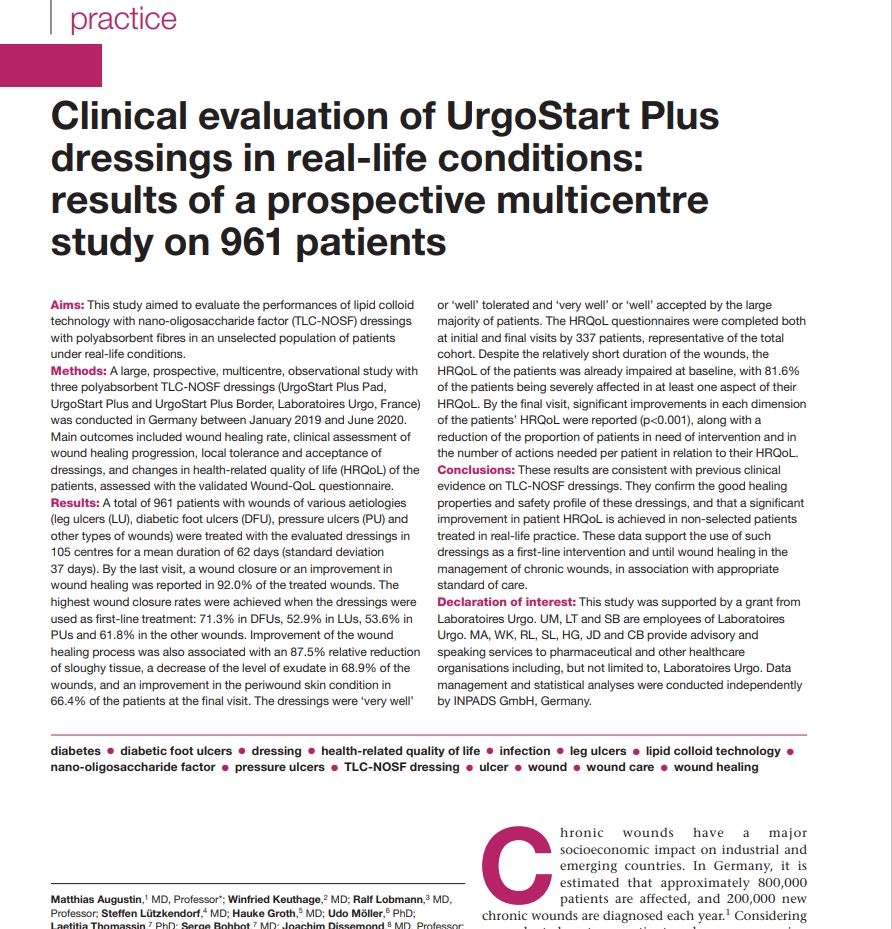
Clinical evaluation of UrgoStart Plus dressings in real-life conditions
Aims: This study aimed to evaluate the performances of lipid colloid technology with nano-oligosaccharide factor (TLC-NOSF) dressings with polyabsorbent fibres in an unselected population of patients under real-life conditions. Methods: A large, prospective, multicentre, observational study with three polyabsorbent TLC-NOSF dressings (UrgoStart Plus Pad, UrgoStart Plus and UrgoStart Plus Border, Laboratoires Urgo, France) was conducted in Germany between January 2019 and June 2020. Main outcomes included wound healing rate, clinical assessment of wound healing progression, local tolerance and acceptance of dressings, and changes in health-related quality of life (HRQoL) of the patients, assessed with the validated Wound-QoL questionnaire.
Richard 2012 DFU
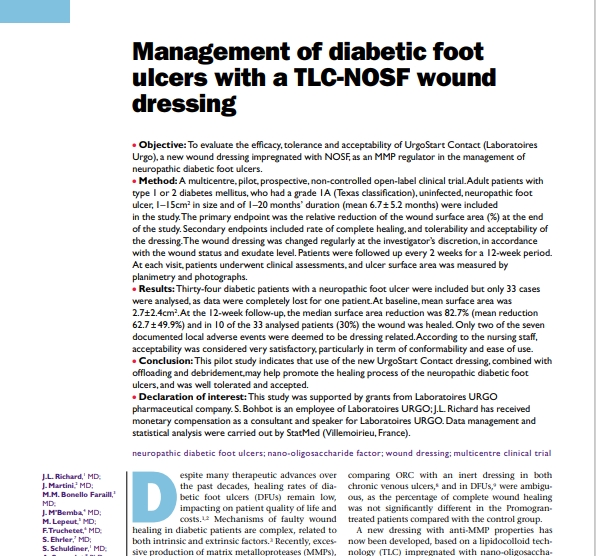
Management of diabetic foot ulcers with a TLC-NOSF wound dressing
Objective: To evaluate the efficacy, tolerance and acceptability of UrgoStart Contact (Laboratoi Urgo), a new wound dressing impregnated with NOSF, as an MMP regulator in the management o neuropathic diabetic foot ulcers. Method: A multicentre, pilot, prospective, non-controlled open-label clinical trial. Adult patients wit type 1 or 2 diabetes mellitus, who had a grade 1A (Texas classification), uninfected, neuropathic foot ulcer, 1–15cm2 in size and of 1–20 months’ duration (mean 6.7±5.2 months) were included in the study. The primary endpoint was the relative reduction of the wound surface area (%) at the end of the study. Secondary endpoints included rate of complete healing, and tolerability and acceptability of the dressing. The wound dressing was changed regularly at the investigator’s discretion, in accordance with the wound status and exudate level. Patients were followed up every 2 weeks for a 12-week period. At each visit, patients underwent clinical assessments, and ulcer surface area was measured by planimetry and photographs.
